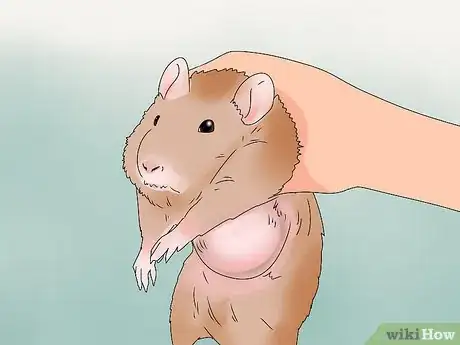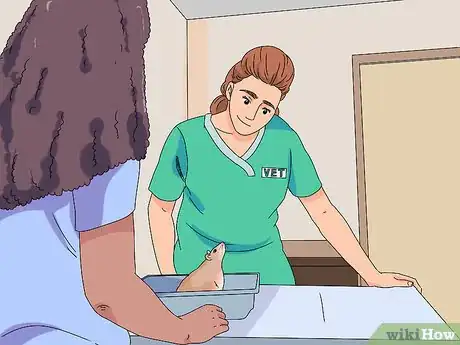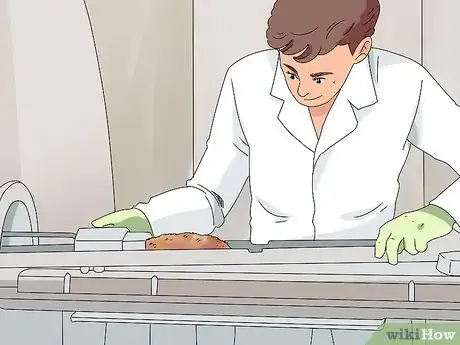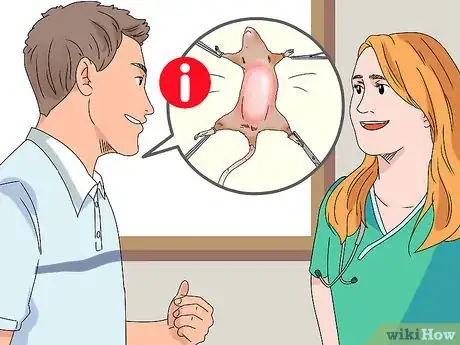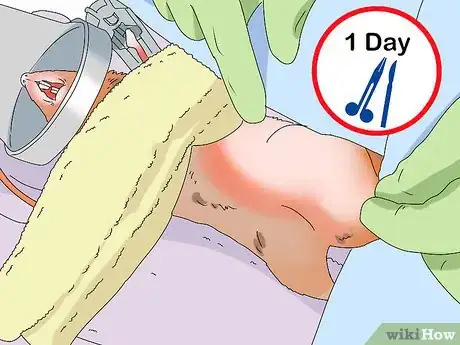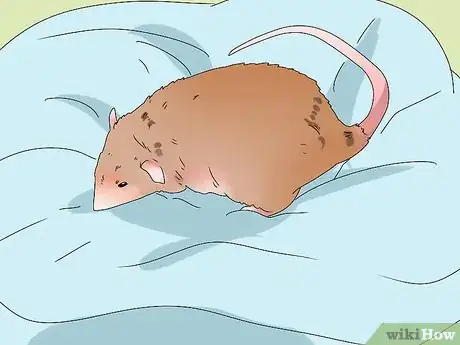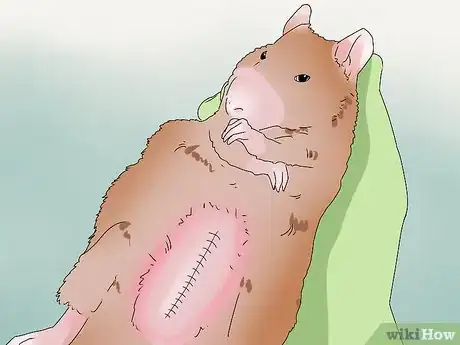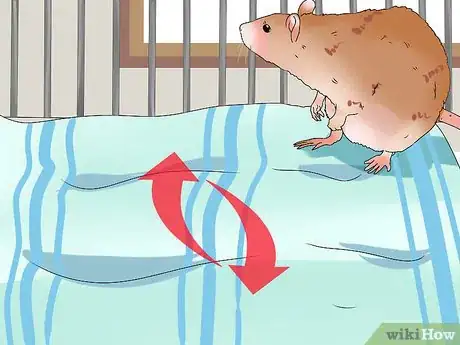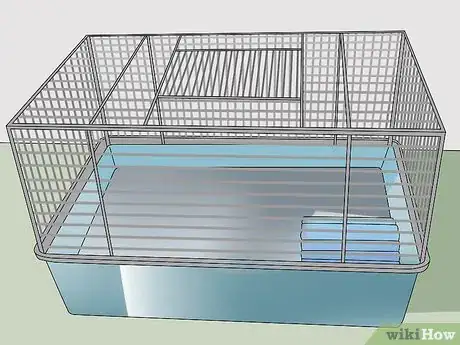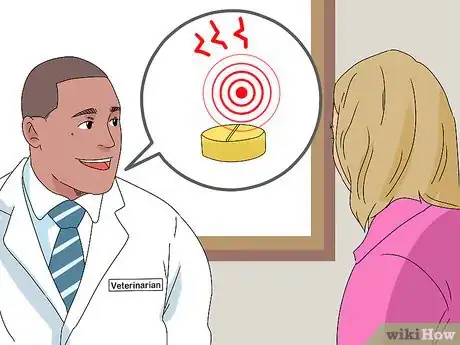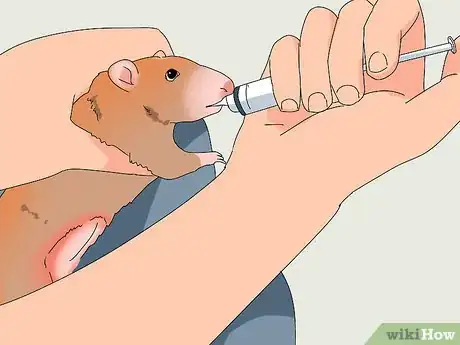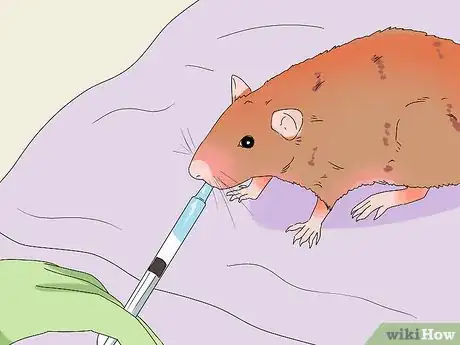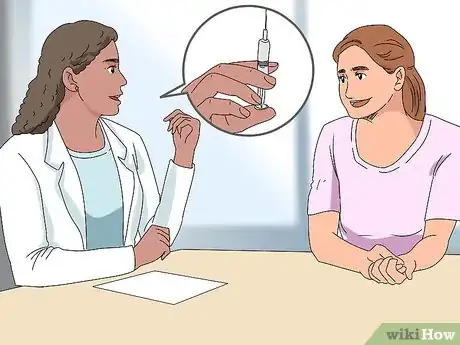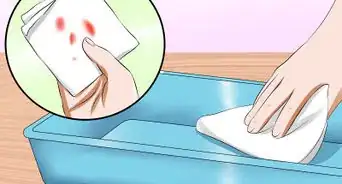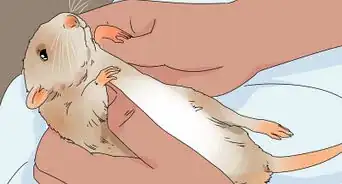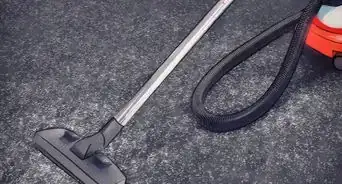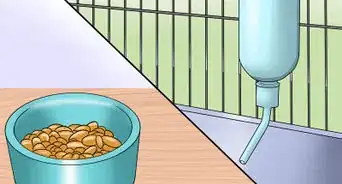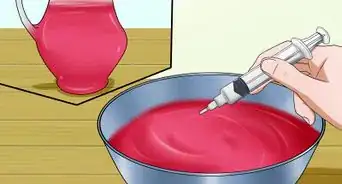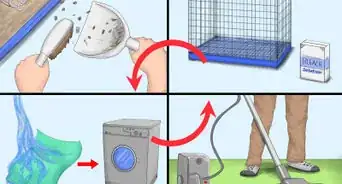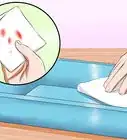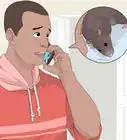This article was co-authored by Pippa Elliott, MRCVS. Dr. Elliott, BVMS, MRCVS is a veterinarian with over 30 years of experience in veterinary surgery and companion animal practice. She graduated from the University of Glasgow in 1987 with a degree in veterinary medicine and surgery. She has worked at the same animal clinic in her hometown for over 20 years.
There are 11 references cited in this article, which can be found at the bottom of the page.
wikiHow marks an article as reader-approved once it receives enough positive feedback. In this case, 93% of readers who voted found the article helpful, earning it our reader-approved status.
This article has been viewed 29,489 times.
Rats make great pets, as they are smart and sociable creatures. Unfortunately, cancer is a fairly common health problem in rats over a year and a half of age, and unspayed females are the most likely to develop this disease. If you think your rat friend has cancer, take it to the vet for diagnosis and treatment, typically surgery. If you decide to care for your rat at home, try to keep it comfortable and feed it by hand as needed.
Steps
Getting a Diagnosis
-
1Watch for the symptoms. Rats with cancer may get listless or lethargic. With certain types of cancer, such as ones that cause cancerous tumors in the pituitary gland, the rat may show signs like confusion and uncoordinated movement. They may tilt their head or even go blind.[1]
- They may also lose the ability to control their front legs.
- Rats with certain types of cancer may also have seizures.
- Your rat may also lose its appetite.[2]
-
2Look for tumors, particularly on the belly. Rats are especially prone to tumors, and they can develop rapidly. Feel for them or watch for them along the abdomen. They will be a solid mass that may or may not move around when you touch it.[3]
- Because rats have such extensive mammary glands, they are most likely to develop tumors along their abdomen. Even male rats are prone to these types of tumors, though they aren't as likely to get them as females.
- Tumors can be benign, meaning non-cancerous, or malignant, meaning cancerous. Malignant tumors tend to be more aggressive.[4]
Advertisement -
3Take your rat to a small pet veterinarian. If you think your rat may have cancer, take it to the veterinarian for diagnosis. They will be able to tell you whether any lumps you've found are tumors and whether they are benign or malignant.
- Not every lump is a tumor. Lumps can also be things like abscesses, swollen lymph nodes, bumblefoot, or a cyst, for instance. Your vet can help you figure out what's wrong.
-
4Expect a few diagnostic tests. Your veterinarian will closely exam your rat, including any tumors it may have. They may also recommend an MRI or ultrasound for it to help diagnose the issue.[5]
Removing the Tumor through Surgery
-
1Discuss the pros and cons of removing the tumor. With young rats in good health, removing the tumor can result in continued good health, particularly if the rat is female and spayed at the same time. Older rats may not tolerate the surgery as well, and you should weigh the age of the rat and the possibility that it will not make the quality of life better for your small friend. Your vet should be able to help you make this decision.[6]
- Rats only live 3-5 years.
- Sometimes, even making the tumor smaller without removing it completely can increase your rat's quality of life.
- Pituitary glands cannot be operated on.[7]
-
2Ask about spaying to reduce the chance of recurrence. These tumors are affected by hormones, and intact female rats have higher levels of hormones than spayed females. Because rats are likely to develop these tumors again, it's a good idea to have your rat spayed while having the tumor removed if she's in good health otherwise.[8]
- Rats with mammary gland tumors are likely to grow more tumors. If you decide to go through with the surgery, you should weigh the fact that new ones could grow in and you may need to have the surgery done again.[9]
-
3Expect a 1-day surgery. This surgery is usually an outpatient surgery. Typically, you'll drop your rat off in the morning and pick it up at night. If you're not comfortable caring for your rat on the first day after surgery, some hospitals will provide boarding for your pet as needed.[10]
Caring for Your Rat after Surgery
-
1Provide a small, separate cage for the rat while recovering. The other rats may try to take care of the healing rat by licking the surgical area or even chewing the sutures, which will delay healing instead. Use a hospital cage if possible.[11]
- A hospital cage is a small cage with no levels which helps keep your rat less active while healing.
-
2Add extra warmth for your rat. While recovering, your rat may benefit from added warmth. Set a heating pad on low and place a thick towel over it. Put the cage on top of it but place it so it only heats up one end of the cage. That way, your rat can move to the other end if it gets too hot.[12]
- You can also use a pet-safe heating pad, such as Snuggle Safe, which you heat up in the microwave. Wrap it in a towel before placing it in the cage.
-
3Check to make sure the sutures stay intact. Some rats may nibble through the stitches, which leaves the wound open for infection. If your rat does this, you'll see an open wound where the surgery was done, and you'll need to take it back to the vet.[13]
- If your rat keeps chewing on the sutures, it may need to wear a collar while it's healing.
-
4Give pain medications as prescribed by your veterinarian. Your vet may prescribe a narcotic like buprenorphine or butorphanol for the first day after surgery. After that, the veterinarian will likely recommend NSAIDs like meloxicam, flunixin meglumine, carprofen, or carprofen.[14]
- If your rat is in more pain than the NSAIDs can deal with, your vet may recommend you go back and forth between the narcotic and the NSAID in the week or so after surgery.
-
5Change the bedding daily. You want to keep the rat's environment as bacteria-free as possible while it's healing. Use bedding made from soft fabric, such as felt, fleece, or t-shirt material, or soft paper towels. Avoid fabric that ravels.[15]
- Avoid litter-type bedding while your rat is healing, as it can stick to the surgical site.
Providing Palliative Care
-
1Use a cage without levels if possible. As your rat's health declines, it will have trouble climbing in a regular cage. Take the levels out of your cage, and just keep it on one level. That way, your rat won't try to climb around or even fall off a level.[16]
- You don't need to move the other rats out. They will usually comfort their rat friend while it is sick.[17]
- Provide soft bedding, such as fleece, flannel, or t-shirt material.
-
2Place a heating pad under one end of the cage. As your rat weakens, it may get cold easier. Turn a heating pad on low and put a towel on top of it. Place it under one side of the cage so your rat can get away from the heating pad if it's too warm.[18]
- Another option is a heating pad you heat up in the microwave. Snuggle Safe is meant for pets. Put a towel around it and set it in the cage.
- If your rat can't move, take extra care to make sure the heat is on the absolute lowest setting because you don't want it to overheat.
-
3Give pain medication as needed. Ask your veterinarian for pain medication to give your rat if it seems to be in pain. It may make noises or have trouble moving if it's in pain. Talk to your doctor about what types of pain medication to give your rat and how often you can give them.
-
4Feed your rat with a syringe as it becomes weaker. Your rat may have trouble eating as time goes by. If that happens, you can feed it using a syringe without a needle. Poke food into a larger syringe (12cc) and push it into a smaller syringe (3cc), then offer it to the rat while you're holding it. Gently press the syringe into the rat's mouth, coming in from the side behind its front teeth. Push in a little food at a time, letting it eat as you do.[19]
- At this point, use any foods your rat likes to eat, such as mashed avocado with added mayonnaise, mashed banana, baby food pudding, or baby food such as cereals, fruits, or dinners. You can also use oatmeal, even one with a flavoring such as maple and brown sugar.
- When feeding the rat, try switching between foods as it loses interest with one.
-
5Give the rat water through a syringe as needed. Add 1 teaspoon (4 g) of sugar to 0.5 cups (120 mL) of water and mix well. Fill a small (3cc), needleless syringe with water, and let the rat drink a little at a time.[20]
- The sugar will encourage the rat to drink and provide extra energy.
- Do this as often as you can. Try once an hour.
-
6Discuss euthanasia if your rat is suffering. If treatments haven't worked or you opted to care for your rat at home, you may eventually want to consider this option. If your rat is obviously having trouble moving around, isn't interested in eating, and seems to be in pain, euthanasia is the most humane option. Discuss this possibility with your veterinarian.[21]
References
- ↑ https://www.veterinary.ie/go/pet_care_notes/rodents/your-pet-rat
- ↑ http://ratguide.com/health/neoplasia/mammary_tumor.php
- ↑ http://www.ratfanclub.org/tumors.html
- ↑ http://www.animalhouseofchicago.com/locations/illinois/chicago-animal-house-of-chicago/articles/tumors-in-rats-diagnosis
- ↑ http://ratguide.com/health/neoplasia/mammary_tumor.php
- ↑ http://ratguide.com/health/neoplasia/mammary_tumor.php
- ↑ http://www.ratbehavior.org/TumorSpaying.htm
- ↑ http://ratguide.com/health/neoplasia/mammary_tumor.php
- ↑ http://www.ratbehavior.org/TumorSpaying.htm
- ↑ https://sawneeanimalclinic.com/downloads/mammary_tumors_in_rodents.pdf
- ↑ http://ratguide.com/health/neoplasia/mammary_tumor.php
- ↑ http://ratguide.com/health/neoplasia/mammary_tumor.php
- ↑ https://sawneeanimalclinic.com/downloads/mammary_tumors_in_rodents.pdf
- ↑ http://ratguide.com/health/neoplasia/mammary_tumor.php
- ↑ http://ratguide.com/health/neoplasia/mammary_tumor.php
- ↑ https://www.veterinary.ie/go/pet_care_notes/rodents/your-pet-rat
- ↑ http://www.rmca.org/Articles/nurse.htm
- ↑ http://ratguide.com/health/neoplasia/mammary_tumor.php
- ↑ http://www.rmca.org/Articles/nurse.htm
- ↑ http://ratguide.com/health/neoplasia/mammary_tumor.php
- ↑ http://ratguide.com/health/neoplasia/mammary_tumor.php
About This Article
To take care of a rat with cancer, keep it in a single-level cage so it can move around with ease. Next, provide soft bedding like fleece, flannel, or t-shirt material to make the cage cozy. Since sick rats tend to get cold more easily, consider placing a heating pad under one end of the cage. If the rat appears to be in pain, ask your vet about pain medications you can give it to make it comfortable. As the rat weakens, you may need to start feeding it with a syringe. To learn about surgical options that could save your rat's life, read on!

